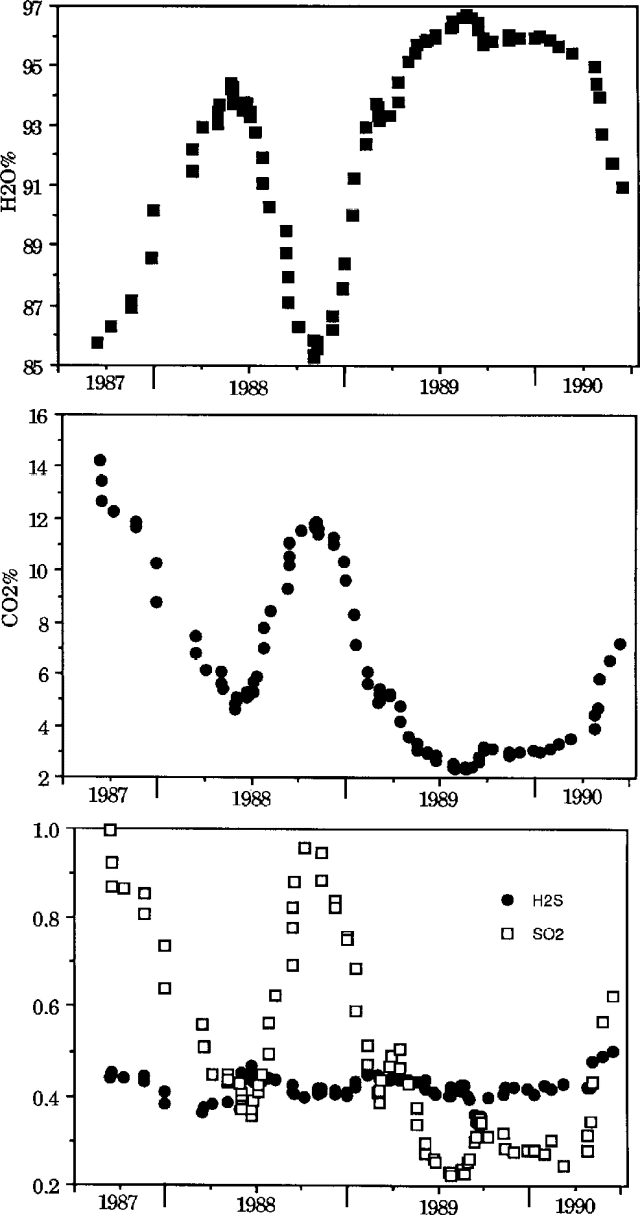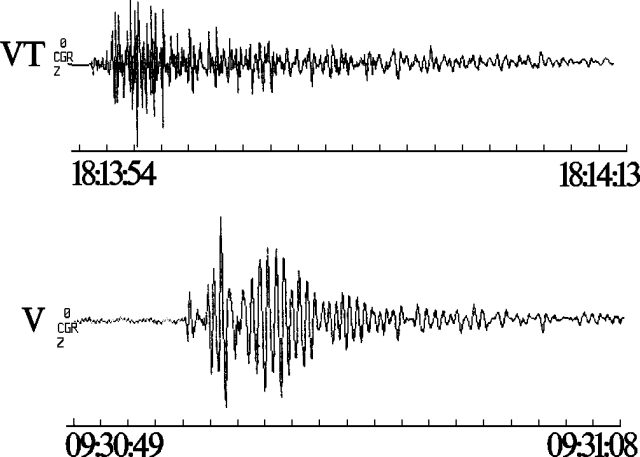Report on Vulcano (Italy) — March 1990
Bulletin of the Global Volcanism Network, vol. 15, no. 3 (March 1990)
Managing Editor: Lindsay McClelland.
Vulcano (Italy) High-temperature fumaroles; gas chemistry; small seismic swarms
Please cite this report as:
Global Volcanism Program, 1990. Report on Vulcano (Italy) (McClelland, L., ed.). Bulletin of the Global Volcanism Network, 15:3. Smithsonian Institution. https://doi.org/10.5479/si.GVP.BGVN199003-211050
Vulcano
Italy
38.404°N, 14.962°E; summit elev. 500 m
All times are local (unless otherwise noted)
Fumarolic activity at Vulcano remained at a very high level in 1989. The temperature of a fumarole (F5) on the crater rim (figure 6) has remained stable at 310 ± 5°C; more than 90 samples have been collected since July 1987. In contrast, a fumarole (FF) inside the crater showed very high temperatures, reaching a maximum of 550°C in August-September 1989, 100° hotter than in 1988. February 1990 temperatures were 515° and 312° at FF and F5 respectively.
Major chemical species (H2O, CO2, H2S, and SO2) showed large variations in concentration (figure 7). 3He/4He ratios were very high for all crater fumaroles (~60% mantle-derived He), remaining stable during 1989 at ~ 7.5-8.0 x 10-6. The 13C/12C ratio followed a similar trend to that of CO2, with very wide oscillations from about d13C 0.00 to -2.20+. Geologists noted that the chemical and isotopic trends suggest mixing of different sources.
 |
Figure 7. Variations in concentrations of H2O (top), CO2, (center) and SO2 and H2S (bottom) at Vulcano's fumarole F5, 1987-90. Courtesy of OV. |
Seismic activity was monitored by a permanent network installed by IIV, and a digital mobile seismic network operated by OV since 1987. Seismicity was at a low level and characterized by low-energy earthquakes occurring in swarm sequences. On the basis of their wave shapes and spectral characteristics, the earthquakes were divided into "Volcano-tectonic" and "Volcanic" events (figure 8) using the classification of Latter (1981). Volcano-tectonic earthquakes outside the Fossa cone and around the island showed clear P and S phases, high frequency contents, and represented the most energetic events (M < 1.6). Volcanic-type events showed very regular wave trains that were sometimes sharply monochromatic, and were characterized by low dominant frequencies and an absence of clearly identifiable phases. Their energy reached 1011-1012 ergs and their magnitudes were negative. Particle motion analysis revealed the presence of Rayleigh and Rayleigh-like waves with a prograde rotation; the arrivals of these two phases followed one another during such earthquakes. Geologists interpreted these events, centered in the Fossa crater, as being related to fumarolic gas flow at shallow depth.
 |
Figure 8. Seismograms showing events classified as "Volcano-tectonic" (top) and "Volcanic" (bottom) at Vulcano. |
Reference. Latter, J.H., 1981, Volcanic earthquakes and their relationship to eruptions at Ruapehu and Ngāuruhoe volcanoes: JVGR, v. 9, p. 293-310.
Geological Summary. The word volcano is derived from Vulcano stratovolcano in Italy's Aeolian Islands. Vulcano was constructed during six stages over the past 136,000 years. Two overlapping calderas, the 2.5-km-wide Caldera del Piano on the SE and the 4-km-wide Caldera della Fossa on the NW, were formed at about 100,000 and 24,000-15,000 years ago, respectively, and volcanism has migrated north over time. La Fossa cone, active throughout the Holocene and the location of most historical eruptions, occupies the 3-km-wide Caldera della Fossa at the NW end of the elongated 3 x 7 km island. The Vulcanello lava platform is a low, roughly circular peninsula on the northern tip of Vulcano that was formed as an island beginning more than 2,000 years ago and was connected to the main island in about 1550 CE. Vulcanello is capped by three pyroclastic cones and was active intermittently until the 16th century. Explosive activity took place at the Fossa cone from 1898 to 1900.
Information Contacts: D. Tedesco, S. Vulcano, and G. Luongo, OV.


